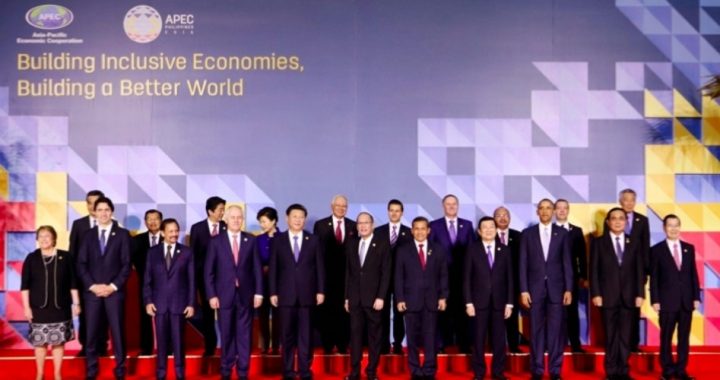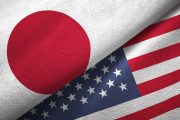
The Asia-Pacific Economic Cooperation (APEC) CEO Summit, held earlier this month in Manila, Philippines, reaffirmed its member-states’ commitment to the proposed Free Trade Area of the Asia-Pacific (FTAAP) through the implementation of regional “trade” schemes, specifically naming the Trans-Pacific Partnership (TPP).
“We reiterate our commitment to achieve the Bogor Goals of free and open trade and investment by 2020 and to the eventual realization of the Free Trade Area of the Asia-Pacific (FTAAP),” the APEC “2015 Leaders’ Declaration” said. Down toward the end of the declaration, it further stated:
We reiterate our belief that the FTAAP should be pursued as a comprehensive free trade agreement by building on ongoing regional undertakings…. In this connection, we note the recent development on the free trade agreements in the region and the progress of the possible Pathways to the FTAAP, including the finalization of Trans-Pacific Partnership (TPP) negotiations.
APEC is a self-described “economic forum” for the Asia-Pacific basin. According to its mission statement, its “primary goal is to support sustainable economic growth and prosperity in the Asia-Pacific region.” APEC’s mission statement further reads:
We are united in our drive to build a dynamic and harmonious Asia-Pacific community by championing free and open trade and investment, promoting and accelerating regional economic integration, encouraging economic and technical cooperation, enhancing human security, and facilitating a favorable and sustainable business environment. [Emphasis added.]
Created by globalist insiders in 1989 to serve the pro-one word government agenda of institutions such as the Council on Foreign Relations (CFR) and the Trilateral Commission (TC), APEC’s primary objective is, as stated above, “promoting and accelerating [the] regional economic integration” of the Asia-Pacific by way of regulated so-called “free and open trade” as its modus operandi.
During his speech at the APEC summit in Manila, Communist Chinese President Xi Jinping cited the “historic step forward” APEC leaders took at last year’s APEC summit in Beijing and stressed the need to continue and accelerate the FTAAP.
“With various new regional free trade arrangements there have been worries about potential fragmentation in this regard. Therefore we need to accelerate the realization of FTAAP and take regional economic integration forward,” Xi said. (Emphasis added.)
APEC’s “2015 Leaders’ Declaration” emphatically made clear two key points: 1) building an FTAAP among APEC’s member-states is the long-term objective; and 2) FTAAP will be developed through the TPP agreement.
The full relevant quote from the “2015 Leaders’ Declaration” is found under the section entitled “Enhancing the Regional Economic Integration Agenda,” where the declaration states:
7. To achieve our vision for an integrated community in a comprehensive and systematic manner.
a. We reaffirm our commitment to advance the process in a comprehensive and systematic manner towards the eventual realization of the FTAAP as a major instrument to further APEC’s regional economic integration agenda. We commend the progress made by our officials on the work on the implementation of the Beijing Roadmap for APEC’s Contribution to the Realization of the FTAAP, which includes the Collective Strategic Study on Issues Related to the Realization of the FTAAP, the Information Sharing Mechanism, and the 2nd Capacity Building Needs Initiative (CBNI). We instruct Ministers and officials to continue this work and, in particular, we look forward to receiving the findings and accompanying recommendations of the Collective Strategic Study when we meet again next year in Peru.
b. We reiterate our belief that the FTAAP should be pursued as a comprehensive free trade agreement by building on ongoing regional undertakings. We also reaffirm our vision contained in the Pathways to FTAAP that it should be high-quality and incorporate and address next generation trade and investment issues. In this connection, we note the recent development on the free trade agreements in the region and the progress of the possible Pathways to the FTAAP, including the finalization of Trans-Pacific Partnership (TPP) negotiations, and we encourage the early completion of negotiations for Regional Comprehensive Economic Partnership (RCEP). [Emphasis added.]
The TPP, or Trans-Pacific Partnership, is a proposed so-called “free trade” agreement negotiated among 12 Pacific Rim nations (Australia, Brunei, Canada, Chile, Japan, Malaysia, Mexico, New Zealand, Peru, Singapore, the United States, and Vietnam) representing 40 percent of world GDP. On October 5, 2015, U.S. Trade Representative Michael Froman announced that the United States and the 11 other participating Pacific Rim nations had reached a final agreement on the TPP.
The RCEP, or Regional Comprehensive Economic Partnership, is another proposed regional “free trade” agreement among 16 countries (Australia, Brunei, Cambodia, China, India, Indonesia, Japan, Laos, Malaysia, Myanmar, New Zealand, Philippines, Singapore, South Korea, Thailand, and Vietnam). With approximately 3 billion people living in these 16 countries, the RCEP represents about 41 percent of the world population and accounts for over 30 percent of world GDP.
Despite mainstream media claims that there was contention or a split during the APEC summit between the TPP member-states and the currently non-TPP states such as Communist China and Russia, there is no evading the facts, which is that the 2015 Leaders’ Declaration was agreed to by all 21 APEC member-states, including China and Russa and all 12 TPP-participatory governments such as the United States.
In other words, all the 12 governments from the participating TPP states agreed and declared that their goal is the FTAAP just as much as it is also the goal of the non-TPP states such as China. This fact completely discredits the narrative a U.S.-TPP vs. China-FTAAP rivalry as perpetuated by both the mainstream media and neoconservative advocacy groups as the American Action Network. The truth is that both the United States and China are working together to create a larger “free-trade” zone known as the FTAAP, and the TPP is by no means an obstacle to that end but rather a means to it.
Photo of APEC leaders: AP Images
Related articles:
China Seeks to Join Trans-Pacific Partnership (TPP)
Globalists Now Pushing To Bring China Into TPP
Chinese Diplomat: TPP, FTAAP “Compatible; Complement Each Other”
Trans-Pacific Partnership To Facilitate U.S.-China Merger




